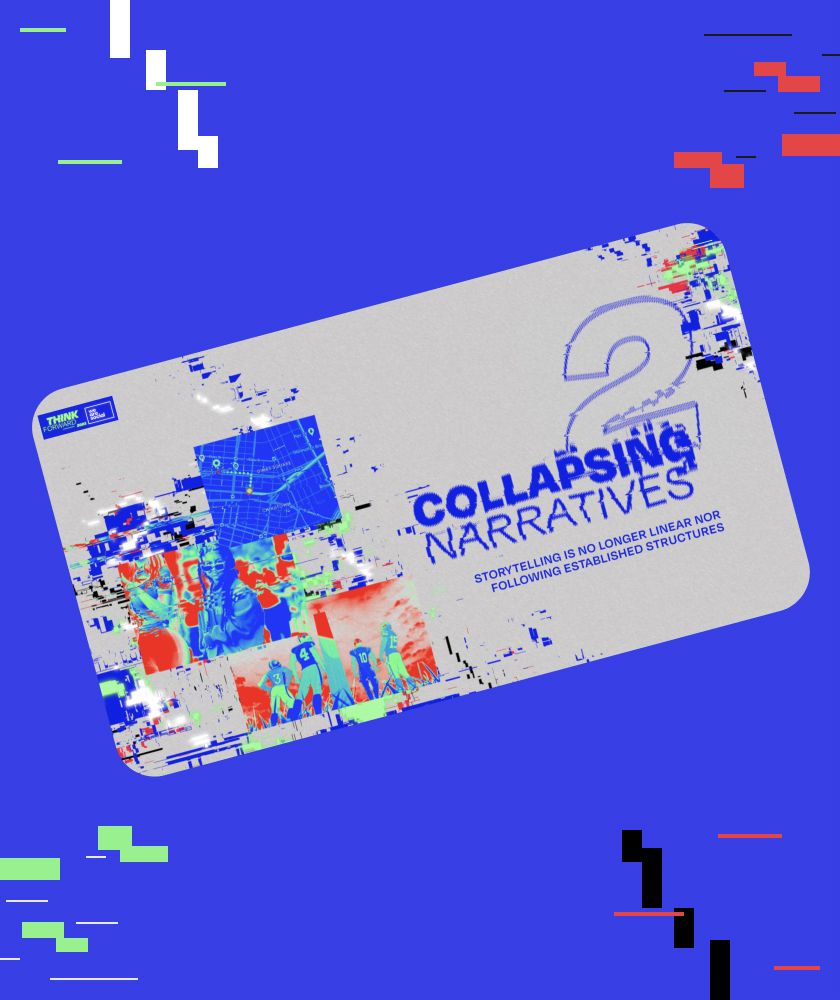Storytelling is experiencing a phase of profound fragmentation. Discover the new dynamics you need to know to communicate with your target audience.

One of the first things I learned when I approached the world of communication, specifically in the "Image Promotion" course at the University of Padua, was that storytelling is crucial if we want our message to be understood and internalized. From there, I became passionate about stories and the psychology behind them, until I explored them in all their forms.
I was looking for stories behind a naming, a product adv, a social post, a rebranding. Stories became, thus, my holy grail. Until yesterday: when I came across wearesocial's "Think Forward" report, which, with its "Collapsing Narratives" focus, punched me in the gut, straight to my CRS organ, Story Reception Center.

What is storytelling and how does it work?
Storytelling is "a communication technique and strategy, which can be applied in a variety of communication contexts. It captures the attention and stimulates the interest of the listener, establishing an emotional connection. Storytelling is a practice that dates back to the dawn of humanity, enchanting women and men since before the birth of writing. The word "storytelling" is rooted in the verb "narrate," meaning to tell in the form of a fable, to narrate, to create a plot through which to develop a story. Before writing, tribes (understood as early human societal forms) used the technique of oral storytelling to pass on traditions, memories, and knowledge. They sang, they drew, they whispered-all to ensure that they were remembered and passed on, on a par with genetic traits in nature.
Storytelling involves people and all their senses, and today, more than ever, one cannot think of communication and advertising without storytelling. Only the cheaper, more primal versions will simply say "hey, look at me, buy me, you need me."
How has storytelling evolved?
"Collapsing Narratives" identified a subtle trend affecting storytelling that alerts us to a potential paradigm shift. Basically, it tells us that "narrative (traditional, ed.) is collapsing" and that "storytelling is no longer linear, nor does it follow a set structure."
I kind of experienced this as a bucket of ice water, but deep down, I expected it: storytelling, just like a technique, evolves, adapts, responds to changes in society and usage.
According to the report, there is no longer a narrative that follows the traditional storytelling pattern (such as fabula, plot, or the interaction of the two), but it has -how to say- "fragmented."

“[...]to survive the modern attention economy, storytelling on social is mutating. [...] they’re collapsing and starting mid-narrative, or expanding and becoming scattered across platforms.”
Fragmentation of storytelling: the evolution of narrative
With the increasingly massive use of social media, narrative has found a new way of existing and responding to people's attention: like a mushroom, it has adapted incredibly well to the new ecosystem, broken up, and each fragment has become a potential generative spore. The "mid-narrative" mentioned in the report refers precisely to this new feature of storytelling, namely that of being able to start new stories at any time within a single narrative strand. People, no longer passive spectators, feel more involved and initiate new narrative strands themselves, through their own interpretations, points of view and sharing, at any point in the pre-existing story.
Today's narratives "are collapsing," and, especially on social, people have taken over the unfolding of the storyline and are becoming protagonists and storytelling voices of the brands themselves.
"Collapsing narratives" tells us that:
- on social, conversations do not take place from start to finish on a single platform, but are transported to other meeting places, thus generating new narrative threads;
- today's narrative culture comes from stories that are already known and told; suffice it to say that the best-selling video games of 2022 are new chapters of pre-existing editions that are well-established in fan communities;
- viral culture today is based on "decoding": GenZ has developed a full-fledged narrative thread (through explanatory videos on TikTok and lengthy Twitter conversations) to explain trending issues, investigate their backgrounds, and put together all the pieces of the puzzle that gave rise to a viral story. A true online investigative society.

Storytelling for brands - The fragmented and multifaceted narrative
You may be wondering: why do we need to shed light on this evolution? What do we need to know it for? The answer is: if we want to continue to have an audience that listens to us, understands us, and remembers us, it is essential to take this into account.
We need to confront the fact that what we are telling is a potential spore, which travels, fragments further, changes language and meets other targets. This may seem alarming and give us the impression that we are completely powerless in the face of such mutability, but it is actually a plus point and a great responsibility: today, our storytelling can reach more people, spark many more conversations, and resonate on other platforms.
I admit, as a story-worshiper myself, I'm a bit scared of it, but I can't help but admire the courage of communication, which changes, responds and never shuts down.
A first interpretation of this trend could encapsulate the following developmental points:
- build courageous content that doesn't just stop at the most suitable channel, but explores new ones: this is the only way they can discover unknown communities and fandoms that have been waiting for nothing more than to receive initial contact;
- ask people to interact to build stories: let's move away from the usual "comment, like, send it to friends," let's ask for sharing that really engages and allows the user to experience our content across platforms;
- get out of the box and experiment with achievements: the Los Angeles Chargers communicated their sports calendar through a short anime, moving away from the usual sports communication and identifying a new niche of fans. Hello, Inter, can you hear me?

In conclusion, I admit I am still conflicted with this narrative collapse thing-I love them in a deep way, stories, and I believe they are of fundamental importance in self-perception as well-but I can't help but take note and collaborate with this new form.
The paradigms of the new corporate storytelling: explore the explorable
After all, we are talking about a new narrative, unseen potentials and virgin scenarios, a return to stories already known and a deepening of them through new conversations.
My plea is to the brands we work with, here at the agency: don't be afraid to learn about new voices, be the protagonists of new dialogues, explore all that can be explored; by doing so, you will not be failing in your values, but you will be offering new blood and finding new possibilities to be known, chosen and remembered.


